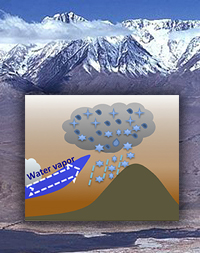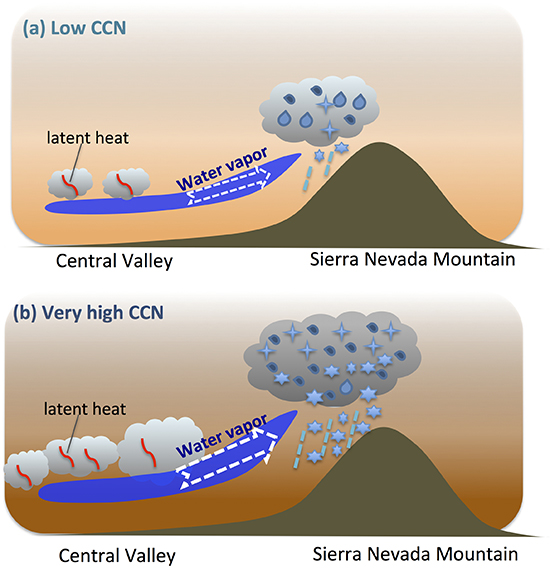Atmospher Sci & Global Chg
Research Highlights
April 2017
Mountain Clouds: From Rain Makers to Snow Makers
Clouds on the windward side of mountains make more snow when served plentiful pollution particles

Pollution-caused atmospheric particles that promote cloud-building and higher cloud condensation nuclei concentrations produce more shallow clouds in the Central Valley and foothills of the Sierra Nevada Mountains. When cloud drops form, latent heat is released that changes local circulation and strengthens the transport of moisture to the windward slope of the mountain. This process of mixed-phase cloud invigoration over the mountains causes greater amounts of snow precipitation than without the injection of pollution particles. Background photo courtesy of Creative Commons license and (inset), PNNL.
Mountains challenge skiers, climbers, and road builders. But when it comes to clouds, they offer an assist. Researchers from Pacific Northwest National Laboratory and Colorado State University found that mountainous, water-ice (a.k.a. mixed-phase) clouds have a dual response when injected with numerous tiny pollution particles. Their study showed that pollution particles near the Sierra Nevada Mountains in the western U.S.A. ripen conditions for forming droplets and ice particles. Initially, mountain-side precipitation decreases. But when the particles reach a certain amount, snowfall dramatically increases over the mountain.
What causes this effect? The team found that high concentrations of pollution particles wafting into the area lead to many more shallow clouds in the California Central Valley and foothills, changing local circulation. Latent heat is given off when the cloud droplet forms, which strengthens the transport of moisture to the windward slope.
"When the pollution particles fill the mountain-side mixed-phase clouds it dramatically increases snow precipitation, and this finding is different from previous modeling studies," said PNNL lead author Dr. Jiwen Fan. "The mechanism leading to this cloud invigoration is our new finding."
Why It Matters: Understanding when and how much snow and rain will fall can help everyone from weather forecasters, to skiers, to farmers and water managers. This study provides a better understanding of the processes that influence mixed-phase clouds and precipitation near mountains. The authors discovered a new mechanism for how pollution-caused particles can stimulate these clouds and dramatically increase snow precipitation. This mechanism also offers important insights for highly polluted mountainous regions in China and India, especially for water cycle and precipitation extremes.
Methods: Researchers at PNNL and Colorado State used the Weather Research and Forecasting regional model and coupled it with revised bin (detailed) cloud microphysics calculations. They compared these very high-resolution model simulations with field measurements from two cloud cases that had contrasting dynamical (winds) and thermo-dynamical (moisture) conditions. The study carried out associated sensitivity simulations with the concentrations of cloud condensation nuclei and ice nuclei changed over a wide range from extremely low to extremely high concentrations to reach their finding.

Higher cloud condensation nuclei (CCN) concentrations (pollution particles) produce more shallow clouds in the Central Valley foothills. The larger latent heat release changes local circulation and strengthens the transport of moisture to the windward slope, invigorating mixed-phase clouds over the mountains to produce larger amounts of snow precipitation.
Not only did the study find that pollution increases snow precipitation, they also found that precipitation can be enhanced as well when ice-forming particle concentrations increased because of increased snow formation.
What's Next? The group will continue to examine the new observation data obtained from the ACAPEX/CalWater2 campaign and conduct model simulations to further understand cloud and precipitation behaviors over the Western United States.
Acknowledgments
Sponsors: This study was supported by the California Energy Commission and the U.S. Department of Energy Office of Science as part of the Regional and Global Climate Modeling program. Paul DeMott acknowledges partial support from the U.S. Department of Energy Office of Science's Atmospheric System Research program.
Research Team: Jiwen Fan and L. Ruby Leung, PNNL; Daniel Rosenfeld, Hebrew University of Jerusalem; Paul DeMott, Colorado State University
Research Area: Climate and Earth Systems Science
Reference: Fan J, LR Leung, D Rosenfeld, and PJ DeMott. 2017. "Effects of Cloud Condensation Nuclei and Ice Nucleating Particles on Precipitation Processes and Supercooled Liquid in Mixed-phase Orographic Clouds." Atmospheric Chemistry and Physics 17:1007-1035. DOI: 10.5194/acp-17-1017-2017
Related Highlights: Distant Desert Dust Increases Snowpack in California
